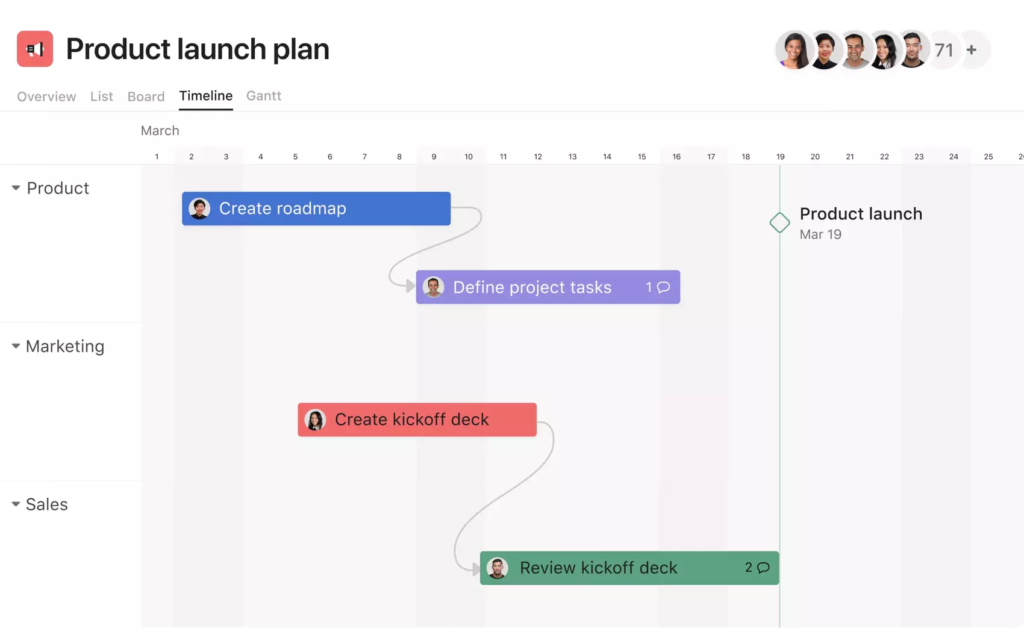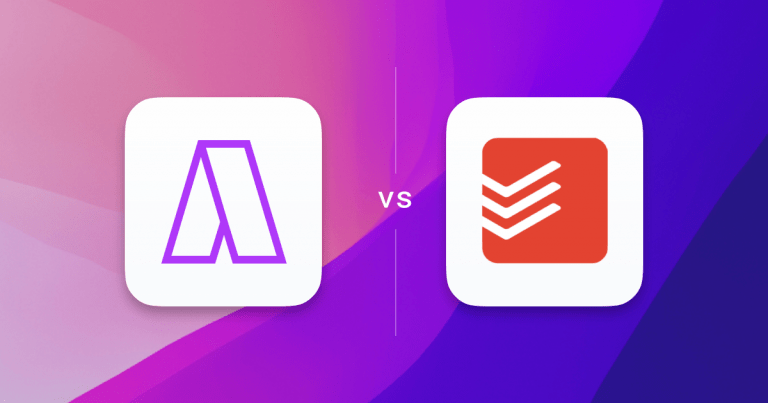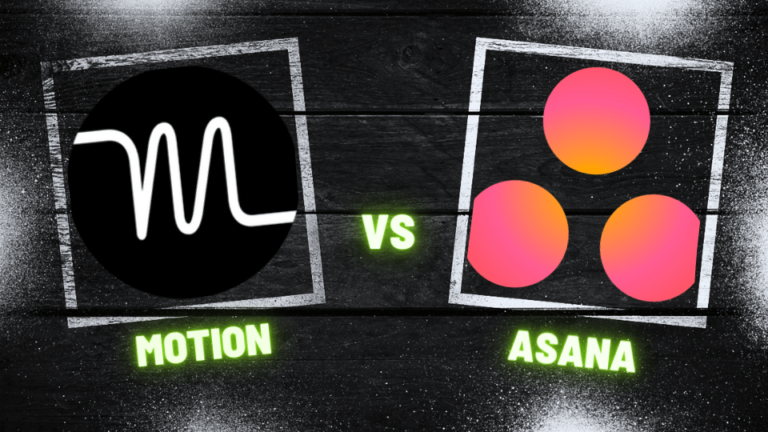What is Asana
Asana stands out as a versatile project management tool, ideal for various team sizes. Its user-friendly interface, coupled with diverse features like task management, project visualization (including Kanban and Gantt charts), and robust team collaboration tools, makes it a top choice. Additionally, Asana’s integration capabilities with other apps enhance workflow efficiency. Offering a range of pricing plans, including a free version for smaller teams, Asana caters to a broad spectrum of organizational needs. It’s particularly recommended for its ease of use, extensive integrations, and comprehensive project management features.

Key Features of Asana
- Task Management: Asana excels in task management, allowing users to create, assign, and track tasks efficiently. This feature ensures that team members are always aware of their responsibilities and deadlines, promoting productivity and accountability.
- Project Visualization: With options like Kanban boards and Gantt charts, Asana offers versatile visualization tools. These features aid in understanding the project flow and milestones, making it easier to manage timelines and resources.
- Team Collaboration: Asana fosters seamless team collaboration. It allows for easy communication within tasks, sharing of files, and updating progress, thus keeping everyone on the same page and enhancing teamwork.
- Integration Capabilities: The platform integrates with a wide range of other applications and tools, streamlining workflows and automating processes. This integration makes it a flexible tool that can adapt to various business ecosystems.
- Customization and Reporting: Asana offers extensive customization options, including custom fields and reporting features. These allow teams to tailor their project management experience and generate insightful reports for better decision-making.
- User-Friendly Interface: The intuitive interface of Asana is designed for ease of use, making it accessible for teams regardless of their technical expertise. This simplicity ensures a smooth onboarding process and enhances overall user experience.
What is Motion
Motion is a productivity tool that stands out for its innovative approach to task and time management. It’s designed to help users not just organize their tasks but also optimize their schedules in real time. Motion employs artificial intelligence to automatically plan your day, taking into account your tasks, meetings, and even preferred working hours. This level of automation and personalization sets Motion apart from traditional task managers. It’s particularly effective for professionals and teams who deal with dynamic schedules and seek to maximize their productivity without the overhead of manual planning.

Key Features of Motion
- Auto-Scheduling with AI: Motion uses AI to automatically reorganize and prioritize tasks based on various parameters such as deadlines, duration, and importance, providing an experience akin to having a personal assistant.
- Project Management Capabilities: While not as extensive as dedicated project management tools, Motion offers effective task organization in a planner-like style. It features Kanban layouts, status, workspace, label, and project categorization.
- Meeting Scheduler with AI: Motion includes a feature for booking meetings, which can be linked externally. This function allows for one-time or recurring booking links, with customizable preferences such as importance, duration, and buffer time.
- Comprehensive Task Management: The app integrates tasks, projects, notes, and team management in one place, with AI assisting in the optimal scheduling and organization of these elements.
- Enhanced Calendar Management: Motion’s calendar function is enriched with AI, which automatically rearranges events and meetings to optimize the user’s schedule.
- AI-Powered Workflow Customization: The AI within Motion continuously learns from the user’s behavior and preferences to adapt and optimize task scheduling and management.
Asana vs Motion: Features
| Features | Asana | Motion |
|---|---|---|
| Integrations | Google Drive, Slack, Zoho Cliq, Zapier, Jira, Zoom, Toggl Track, Loom, Harvest, Gmail | Google Calendar, Zoom, Zapier, and Microsoft Teams, Gmail,Outlook |
| Calendar | Yes | Features an intelligent calendar that integrates with existing calendars |
| Platforms | macOS, iOS, Android, Web, and Windows | Available on multiple platforms, including mobile and desktop |
| Task Management | Task creation and assignment, due date setting, progress tracking, project organization, tagging, comments, file attachments, task conversations | Includes AI-driven task prioritization and dynamic scheduling adjustments |
| Natural Language Processing | Yes | Yes |
| Time Blocking | No | Available |
| Analytics | Yes | No |
| Meeting Scheduler | No | Yes |
| Time Zones | Yes | Yes |
| Reminders | Yes | Yes |
| Customer Support | Average | Average |
| 1:1 User Onboarding | Asana offers customer success services including tailored training and consultation, which might include onboarding calls for new users, especially in enterprise plans | No |
| Pricing | Asana offers three plans: the free Personal plan for basic needs, the Starter plan at $11.59 for expanded features like timeline view, and the Advanced plan at $25.69 for comprehensive project management tools including time tracking and advanced customization. | $19 per month, annually |
Asana vs Motion: Pricing
Asana Pricing
Asana offers three main pricing tiers:
(i) Personal: This is a free plan, suitable for small teams or individuals. It includes basic project and task management features and supports collaboration with up to 10 team members. Users have access to unlimited tasks, projects, messages, and file storage.
(ii) Starter: Priced at $11.59 per user per month, this plan builds on the Personal plan. It allows collaboration with up to 500 teammates and introduces additional features like timeline and Gantt chart views, along with the ability to use forms and automation.
(iii) Advanced: At $25.69 per user per month, the Advanced plan includes all features from the lower tiers and adds functionalities such as goals, time tracking, proofing, approvals, and more advanced customization options.
Each tier offers a range of features to accommodate different needs, from individual use to more complex team collaboration and project management requirements.
Motion Pricing
Motion offers two pricing plans:
(i) Individual Plan: $14 per month when billed annually, or $34 billed monthly
(ii) Team Plan: $12 per user per month when billed annually, or $20 billed monthly
Asana vs Motion: Reviews
Asana Review
Asana, a popular project management tool, is praised for its intuitive interface and robust feature set, making it an excellent choice for teams of all sizes. Key strengths include versatile project views, effective task and assignment management, and smooth team collaboration. Users benefit from a variety of project views like Kanban Board, Timeline, and Gantt, alongside templates for quick project setup. Asana’s progress tracking and integration with various tools like Google Suite and Microsoft 365 further enhance its utility. However, the tool’s complexity might be overwhelming for beginners, and the cost of the Advanced package may be a concern for smaller teams or individual users.
Motion Review
Motion is a comprehensive task management tool with AI-driven scheduling features. It excels in automating and prioritizing tasks, but it might not be ideal for those who prefer less manual task input, as it requires detailed information for effective task prioritization. While it offers project management capabilities, these may not be sufficient for larger teams or those needing a wide range of view options. The interface can be complex due to its numerous features, and its price point is also higher compared to some competitors, which could be a consideration for users with budget constraints.
Which One Should You Pick
Consider Asana if
- You’re Managing Diverse Projects: Asana is suitable for various project types, offering flexibility with multiple view options like Kanban and Gantt charts. However, it might take time to master all the features.
- You Value Integration: Asana’s integration with many tools (like Google Suite, Microsoft 365) enhances its utility. But, be mindful that depending on external apps could complicate workflows.
- You Prioritize Team Collaboration: Asana is strong in team collaboration features, making it easy to track responsibilities and updates. Still, for very small teams or individual use, the platform might offer more than needed.
Consider Motion if
- You’re Interested in AI-Assisted Scheduling: Motion’s AI auto-scheduling can be helpful, but it might be overwhelming for those new to such technology or who prefer more control.
- You Need Basic Project Management Tools: While Motion offers some project management capabilities, it may not be comprehensive enough for complex project needs.
- You Want Integrated Meeting Scheduling: Its meeting scheduling feature is convenient, but might not offer the flexibility of dedicated scheduling tools.
Best Asana and Motion Alternatives
- Akiflow: Akiflow is a time management app offering time blocking, task scheduling, and integrations with various tools. It focuses on productivity and organization through a unified task and appointment interface.
Akiflow Price: $19 per month, paid annually - Todoist: Todoist is a task management tool. It enables users to manage tasks, set priorities, and track deadlines across various devices. Its features include task categorization, reminders, and project collaboration, making it suitable for both personal and team productivity.
Todoist Price: Premium at $4 per month, paid annually - Trello: Trello is a visual collaboration tool for planning tasks and projects. With an intuitive interface of boards, lists, and cards, it helps teams organize work and manage projects effectively.
Trello Price: Free Plan for individuals and small teams, Standard Plan at $5 per user/month (billed annually), Premium Plan at $10 per user/month (billed annually), and an Enterprise Plan for larger organizations at $17.50 per user/month (billed annually)

Best Time Blocking Web and Desktop Apps, 2024
Explore the best time blocking apps of 2024! Discover how Akiflow, TickTick, Usemotion, Sunsama, Sortedapp, and TimeHero revolutionize productivity, offering unique features for professionals and students to manage tasks and enhance efficiency.

Improve Focus: 5 ADHD Productivity Tools & Calendar Apps for 2023
Discover five of the best apps and tools for those with ADHD, from note-taking apps to time-blocking platforms. Get ready to stay organised, motivated and on track with Akiflow’s essential guide.

The Top 3 Todoist Alternatives (In-Depth Review)
Over 25 million people now use Todoist to stay on track and plan their day. It has expanded rapidly and is now a widely used task manager with seamless integrations into other task and calendar managers like Akiflow. While Todoist is hugely popular among its wide user base, there are now a variety of Todoist […]

